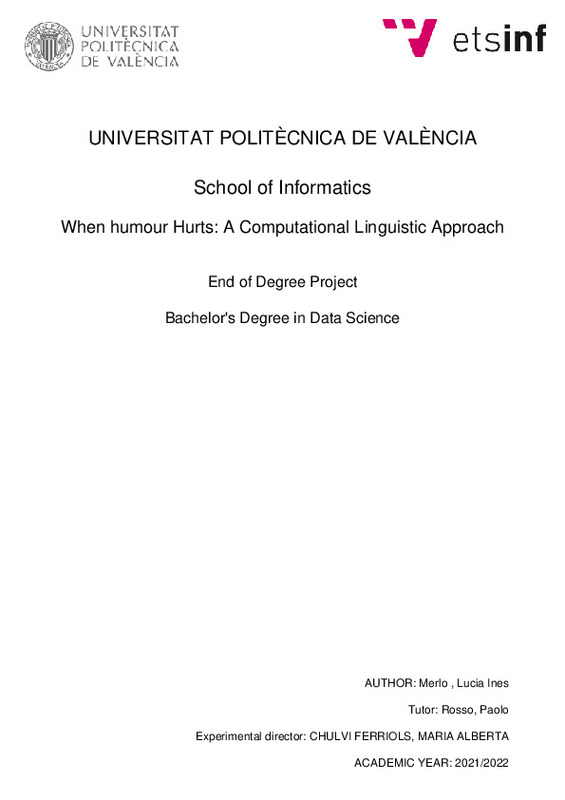JavaScript is disabled for your browser. Some features of this site may not work without it.
Buscar en RiuNet
Listar
Mi cuenta
Estadísticas
Ayuda RiuNet
Admin. UPV
When humour Hurts: A Computational Linguistic Approach
Mostrar el registro sencillo del ítem
Ficheros en el ítem
| dc.contributor.advisor | Rosso, Paolo
|
es_ES |
| dc.contributor.advisor | Chulvi Ferriols, María Alberta
|
es_ES |
| dc.contributor.author | Merlo, Lucía Inés
|
es_ES |
| dc.date.accessioned | 2022-10-18T17:14:36Z | |
| dc.date.available | 2022-10-18T17:14:36Z | |
| dc.date.created | 2022-09-19 | |
| dc.date.issued | 2022-10-18 | es_ES |
| dc.identifier.uri | http://hdl.handle.net/10251/188166 | |
| dc.description.abstract | [EN] Traditionally, humour is considered as a funny way of communication. Although it can achieve laughter in the receptor by making use of non hurtful language, it is not always like that. Frequently, humour is applied to address controversial topics, sometimes being hurtful to a person or people who belong to certain groups. Hence, nowadays some researches focus on how hate speech is disguised into humour. The main objective of this study is to use a computational linguistic approach to detect in humorous texts, which are the characteristics that distinguish high and low levels of offence in jokes. Variables detected as relevant in the previous characterisation are applied into a classification model. With this second step, this work analyses how well a Machine Learning model performs, and by applying an ablation test, variables that stand out within the classification task are identified. | es_ES |
| dc.description.abstract | [ES] Tradicionalmente, el humor se considera una forma de comunicaci´on divertida. Aunque puede provocar la risa del receptor haciendo uso de un lenguaje no hiriente, no siempre es as´ı. Con frecuencia, el humor se utiliza para abordar temas controvertidos, resultando en ocasiones ofensivo para una persona o grupo de personas. Por ello, en la actualidad, algunas investigaciones se centren en c´omo el discurso del odio se disfraza de humor. El objetivo principal de esta investigaci´on es utilizar la ling¨u´ıstica computacional para detectar en los textos humor´ısticos cu´ales son las caracter´ısticas que distinguen niveles altos y bajos de ofensa en los chistes. Las caracter´ısticas detectadas como relevantes se utilizan un clasificador. En esta segunda parte del trabajo se analiza el rendimiento de un modelo de Machine Learning y, mediante la aplicaci´on de un test de ablaci´on, se identifican las caracter´ısticas m´as relevantes en la tarea de clasificaci´on. | es_ES |
| dc.format.extent | 82 | es_ES |
| dc.language | Inglés | es_ES |
| dc.publisher | Universitat Politècnica de València | es_ES |
| dc.rights | Reconocimiento (by) | es_ES |
| dc.subject | Humor | es_ES |
| dc.subject | Lenguaje ofensivo | es_ES |
| dc.subject | Lingüística computacional | es_ES |
| dc.subject | Humour | es_ES |
| dc.subject | Offensive language | es_ES |
| dc.subject | Computational lingüistics | es_ES |
| dc.subject.classification | LENGUAJES Y SISTEMAS INFORMATICOS | es_ES |
| dc.subject.other | Grado en Ciencia de Datos-Grau en Ciència de Dades | es_ES |
| dc.title | When humour Hurts: A Computational Linguistic Approach | es_ES |
| dc.title.alternative | Quan l'humor fa mal: un enfocament lingüístic computacional | es_ES |
| dc.title.alternative | Cuando el humor duele: un enfoque lingüstico computacional | es_ES |
| dc.type | Proyecto/Trabajo fin de carrera/grado | es_ES |
| dc.rights.accessRights | Abierto | es_ES |
| dc.contributor.affiliation | Universitat Politècnica de València. Departamento de Sistemas Informáticos y Computación - Departament de Sistemes Informàtics i Computació | es_ES |
| dc.contributor.affiliation | Universitat Politècnica de València. Escola Tècnica Superior d'Enginyeria Informàtica | es_ES |
| dc.description.bibliographicCitation | Merlo, LI. (2022). When humour Hurts: A Computational Linguistic Approach. Universitat Politècnica de València. http://hdl.handle.net/10251/188166 | es_ES |
| dc.description.accrualMethod | TFGM | es_ES |
| dc.relation.pasarela | TFGM\152284 | es_ES |
Este ítem aparece en la(s) siguiente(s) colección(ones)
-
ETSINF - Trabajos académicos [4769]
Escola Tècnica Superior d'Enginyeria Informàtica






